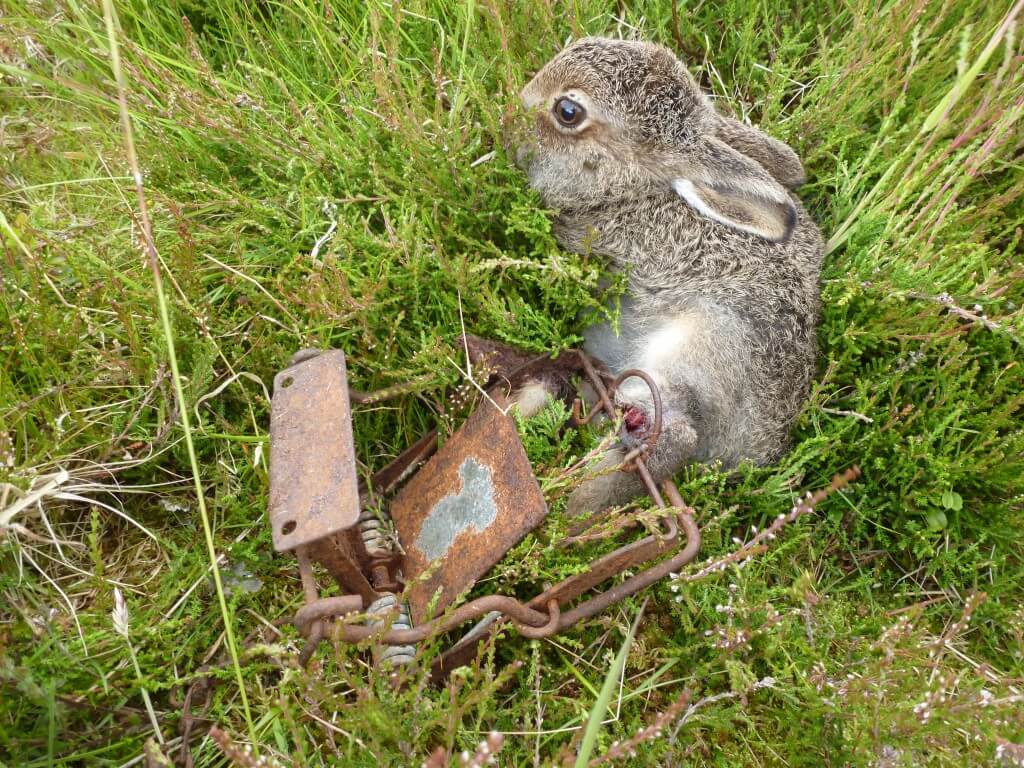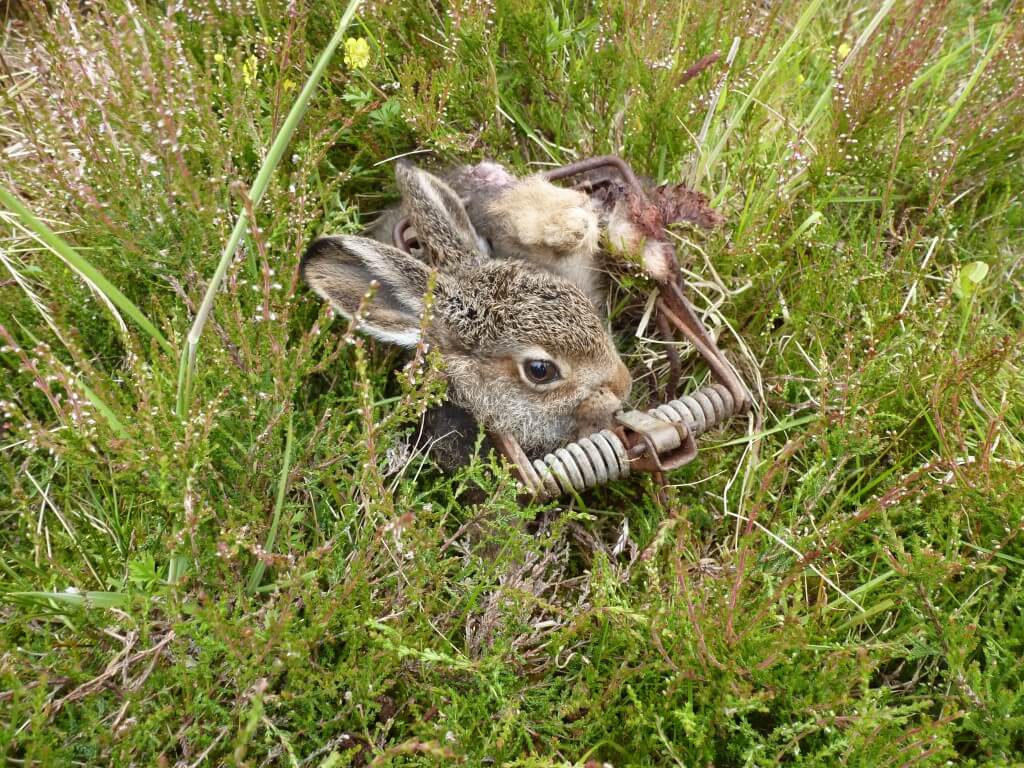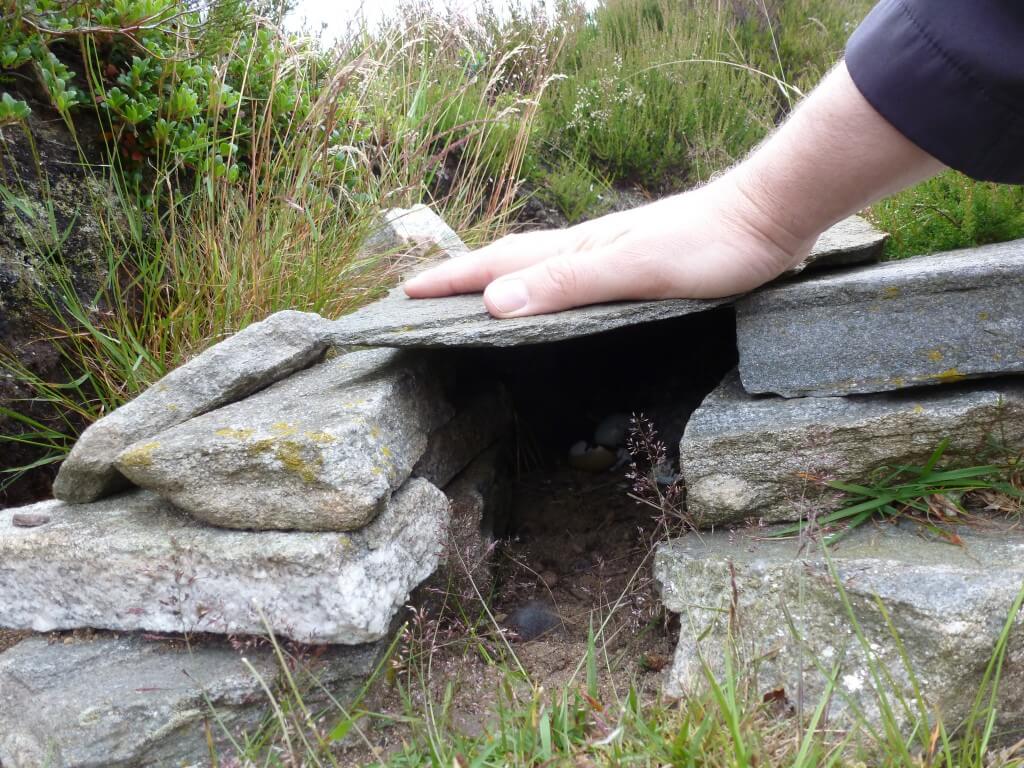I don’t say much about the animal welfare aspects of grouse moor management – they are well-covered by others and they aren’t my main gripe with the whole system of land management (does that sound hard-hearted?).
But these photos (which you should find upsetting) of a Mountain Hare leveret caught in a fenn trap touched me. Intensive predator control, legal predator control, is a major part of the management needed to deliver massively unnatural densities of Red Grouse for the pastime of Red Grouse shooting.
This leveret was photographed on a grouse moor in the east highlands of Scotland in late July. It was found by a walker who reported it to the SSPCA as he wondered whether this was legal – largely because the entrance to the trap seemed very large (ie very indiscriminate) to him. He reckoned that an Otter or Pine Marten was at risk from this trap.
The trap looks a rusty old thing doesn’t it?
Assuming that the leveret had been caught in the untethered trap originally set in the stone blind tunnel (see below)(which was baited with bits of egg and hare) then it had crawled about 8m from where it was caught. The leveret was caught by two legs. It was euthanised.
I’m told that the SSPCA advised that this trap was entirely legally set. This then is a legal by-product of driven grouse shooting and is required so that people can shoot Red Grouse for fun.
If this leveret had survived and grown up it would still be regarded as vermin on many grouse moors (see Inglorious pp 7, 19, 76, 126 and 237).
Watch the video mash-up of Henry’s travels on YouTube.
[registration_form]



There is no way that this trap was legally set – they should be in a tunnel of restricted entrance, limiting access to all but stoats, weasels and rats. You could just about drive a bus into this one! Even, however, where the entrance is restricted to an aperture of just 2-3 inches, theoretically limiting by catch, we still get a variety of passerines caught in these things – mipits, dippers and, most worryingly given their conservation status, ring ouzels. I urge anyone coming across one of these, if it has caught a non-target species, or there is a concern that the tunnel entrance is too wide, to report it to a police WCO and/or the RSPB Investigations team.
Ian – thank you. I will pass that message on to the person who found this.
As I do very much care about the welfare of animals – it seems a perfectly reasonable concern – it’s irrelevant whether snares are legally or illegally set.
They should be banned.
That such cruelty should be acceptable to governments, landowners, gamekeepers, the general public, whoever, is appalling.
I dont see a number marked on the thing in the photos…it has to have a registration number to be legal.
Fenn traps (the one in the photo) do not need a ‘registration number’ painted on them in England and I am not aware of this requirement in Scotland to be legal. Traps have to be ‘type approved’ details of which will be stamped on every trap (visible only on bright metal when new). This refers though to the design and not to individual traps. In Scotland this is covered by ‘Spring Traps Approval (Scotland) Order 2011’
Please ignore ‘painted’…..I missed deleting for some reason. Blame Monday!
I can’t see why it would be ok for a stoat,weasel or rat to die like this either.
Eleri – fair point.
I will never understand things like this – ‘legal’ or not – it’s just wrong.
Gamekeeping is a cruel and sick occupation. According to Animal Aid, an estimate of 5 million animals are legally killed every year to “protect” game birds. Mark has wondered what a pile of 600 stoats (killed every year by two grouse moors) by the side of the road would look like, but imagine seeing the above figure!
With this in mind, and the atmospheric and water pollution caused by burning it is ludicrous that the role of the gamekeeper is spun by the shooting industry as being beneficial for conservation. The championing of waders and how they benefit from their extreme use of land is largely an irrelevance when the above is factored in. It is nothing more than a convenient smokescreen, particularly when three species of water can legally be shot – golden plover, snipe and woodcock.
Gamekeepers are so used to killing wildlife, that it’s not really surprising that they kill birds of prey too, despite the latter’s legal protection.
Whilst I find it hard to contradict your sentiments, we need to keep a grip in claiming the moral high ground. How many animals are killed each year in the name of food, and I’m not just talking meat production? Already today we will all have paid for the legal destruction of large amounts of our native wildlife, as well as that of foreign native flora and fauna. That’s what all the biocides do that we allow to be sprayed willy-nilly to enable us to eat ‘cheap low quality food’.
The argument ‘but we need them for the way we produce our food’ is similar to the argument ‘we need to kill predators so we can produce the number of grouse’.
Dont vilify gamekeepers for carrying out legal pest control. There are other places for that, try lobbying for a change in the law but don’t forget to lobby for a ban on biocides at the same time (a ban on which would be far more valueable for our ecosystem than any other I can think of).
Anyway where was I?……….
Probably a good number of those to whom animal welfare is important are concerned enough by what you rightly say, Martin, to abstain from animal products and to campaign against toxic chemicals sprayed around the environment.
Many don’t think ridiculously cheap food is necessarily a good thing either, in a country such as ours.
And why use the word ‘pest’? Every creature has his or her place in the world and surely we can respect that, not for ever be eradicating those beings we judge are in competition with our interests.
Well done, Mark, for highlighting this aspect of game rearing, not, I’m sure restricted to grouse moors. Legal or not, the more oxygen of publicity given to such practices the better. I’m sure most of the general public have little idea of what really goes on in our countryside.
Pest….
‘an annoying or troublesome person, animal, or thing; nuisance.’ Which to gamekeepers is anything that harms or or reduces the ‘crop’ they are charged with protecting.
Pest….
‘an annoying or troublesome person’ i.e. Gamekeeper
.
Vilifying gamekeepers for carrying out legal pest control? If the trap was set in the tunnel in the photograph it is almost certainly illegal. See the conditions for the setting of Fenn Mark IV traps in the legislation (Section 6):
http://www.legislation.gov.uk/ssi/2011/393/schedule/made
Is the tunnel “suitable for minimising the chances of capturing, killing or injuring non-target species”? The finder should report the incident to a Police Wildlife Crime Officer to investigate.
Judging from the photo of the tunnel, you are correct in that it looks illegal and should be reported. My comment regarding not vilifying keepers for legal use of traps was meant as a general point and was made to try and keep the current debate firmly focussed on HH persecution.
How ironic this post is. Last night I watched ‘The Untold Story: Driven Grouse Shooting’ https://www.youtube.com/watch?v=fsMkt04XKVs set in the infamous bird of prey persecution blackspot the Angus Glens. Even last night I struggled to get through it without losing my dinner – but you need to keep informed about what they are up to. All the lovely kind keepers telling us that without them and driven grouse shooting the local economy there would be shattered and wildlife, including golden eagles, peregrines and sparrowhawks etc would be lost – all the mountain hares the grouse moors have provide excellent food for eagles! Certainly wasn’t impressed by the number of jobs the GMs create, seem to be pathetically few and poorly paid and the presence of grouse moors look as if they exclude a lot of other options such as general recreation and eco tourism. This pile of saccharine pap was brought to us by Pace Productions who I believe are also involved in ‘You Forgot about the Birds’. Obviously the propaganda, PR machine is gearing re up the GMs, but hopefully will just serve to make them look ever more ridiculous. The real untold story is being told here, on the Raptor Persecution Scotland website and amongst those who really know about wildlife and what’s happening to it on our uplands.
Is this a good time to ask why we’re not referring to grouse shooting as a ‘blood sport’?
Probably not. See the first paragraph in this blog.
Martin WW – am I really losing my grip because I care about the amount of native wildlife that is killed by gamekeepers?
“Don’t vilify gamekeepers for carrying out legal predator control. There are other places for that….” – what a bizarre statement. Just because something is legal, it doesn’t mean that I have to agree with it and I think commenting on a blog that highlights the cruel, but legal trapping (although the way the trap may have been set up in the case of the mountain hare may have been illegal according to another commenter), seems an appropriate place to share my views.
Your point about food production also seems confused. I agree that some farming is too intensive, but ultimately gamekeepers kill native wildlife so that people can shoot gamebirds for ‘fun’. At least farming’s main reason is to provide food. That is something that we all need, we don’t all need to shoot animals for enjoyment.
Of course you’re not losing your grip. You have every right to be concerned as we all are.
It wasn’t meant to come across as a bizarre statement. In the context of this ‘comments’ section commenting on ‘By-catch’ I don’t think this is the right place to discuss legal pest control. If Mark blogged on legal pest control and its cruelty etc etc then by all means.
As to the comments on food production, if they appear confused I apologise, but my inability to type with more than one finger and having other things to do massively limit the time I spend exploring ideas on here fully.
Not mentioned here is that these tunnel/log traps become highways for small mammals like voles. The scent is well placed in the tunnel hence why most predators of these will venture in. Most have no restriction and I have a picture of a tawny owl caught in one. Protected mammals of various ages like Wild Cat, Pine Marten, Polecat, Otter and even Red Squirrel are caught in them. I used to see vast numbers of squirrels caught in them every day I worked in Forestry. So tell me ‘How are they legal’!!
I have personally seen a pine martin in a trap on a grouse moor Perth, so protected spp certainly do get caught in them too.
On a separate note, just as we rightly object when grouse shooters attack Mark/RSPB rather than addressing the issues, it’s probably unhelpful for our side to make generic attacks on gamekeeping and gamekeepers, esp since this campaign is specifically about driven grouse shooting and not shooting in general. Whatever the role they play it’s pretty obvious that gamekeepers are just the footsoldiers for much more powerful interests. There are better targets for our scorn.
By the very nature of what they do keepers are anti-social and desensitised to the natural world, and along with their mindless bosses, are operating killing fields. In a just society they’d all be be driven out of the countyside and encarcerated. It’s your comment that seems ‘unhelpful’.
On land where these traps are heavily used there must be a high risk of non-target by-catch.
I agree with the first comment that the risk to species such as ring ouzel may be considerable. I was once horrified to accidentally catch a blackbird in a rat trap that I thought was quite securely located 40-50cm into a 5cm gap underneath my hen house. A baited fenn trap would surely be attractive to a foraging ring ouzel.
I’ve also heard of a Scottish estate where the very last male capercaillie was killed in a snare. Slight digression but many keepers are pushing for the pine marten to be held responsible for the fall in capercaillie numbers rather than crap springs and restricted habitat, but have also stopped humane deer culls and forced conservation organisations to use deer fencing to regenerate woodland instead. Of course this is major source of bird strikes including capers and black grouse – but the keepers seem to conveniently ‘forget’ that.
It seems to me that as used here the Fenn trap is indistinguishable from the gin trap which definitely is illegal.
Arguably there is a welfare distinction between correctly used Fenn traps which should kill instantly and the amount of fear and pain caused if an animal is simply caught by one or more limbs.
The killing legal and illegal is distasteful to just about everyone whether they live in town or countryside.